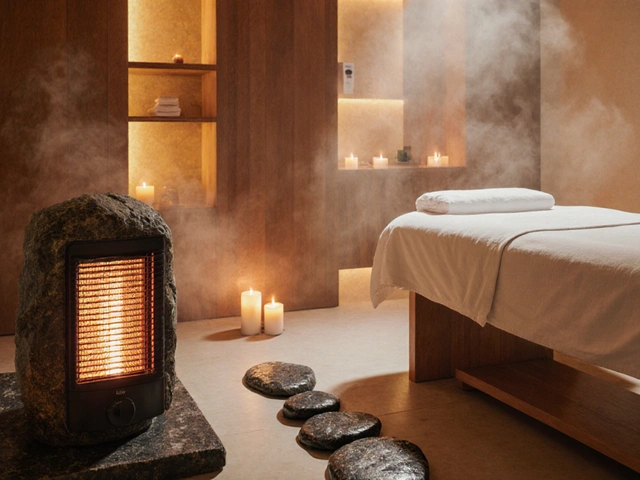Acupressure: Discovering the Healing Power at Your Fingertips

Some days just sneak up with aches—lower back, headaches, or that tense neck from too much scrolling. Before you reach for another pill, have you tried pressing on certain spots with your fingers? Acupressure sounds super old-school, but it’s weird how effective a few minutes on a pressure point can feel.
You don’t need to book a spa session or buy anything fancy. Some of the best spots for easing pain or stress are right where you can reach—like the base of your thumb or between your eyebrows. Acupressure uses your own hands to unlock relief. It’s based on the idea that certain points on your body connect to muscles and internal systems. Press, hold, breathe, and—sometimes—things just start to unclench.
Got a headache that refuses to quit? Rubbing a point between your thumb and index finger can help. Trouble sleeping? Try a spot on your inner wrist. It's not magic—just practical body know-how you can use while binge-watching, commuting, or even waiting for your coffee. Because honestly, nobody wants pain to take over their day if pressing your fingers could make a difference.
- What Is Acupressure?
- The Science Behind Acupressure
- Getting Started: Tools and Safety
- Easy Points for Everyday Relief
- Acupressure Routines for Common Ailments
- Smart Tips to Maximize Results
What Is Acupressure?
So, what exactly is acupressure? Think of it as the hands-on cousin of acupuncture, but without the needles. Instead, you use your fingers, thumbs, or even a blunt object to press on certain points of your body. These spots are believed to be connected by energy pathways known as meridians, a concept rooted in Traditional Chinese Medicine. The goal? To balance your energy, help your body relax, and kick pain or tension to the curb.
This method isn’t new. It’s been around for thousands of years, mainly in Asian countries like China and Japan. Now, more folks around the world are realizing that simple finger pressure can make a difference for stress, muscle pain, and even digestion issues.
But how does it work? Some scientists say acupressure may switch on the body’s self-healing abilities by encouraging the release of feel-good chemicals (endorphins), increasing blood flow, and relaxing tight muscles. There’s also research showing it can help with headaches, nausea (like morning sickness or after surgery), and chronic back pain.
| Benefit | Common Point | Extra Fact |
|---|---|---|
| Headache Relief | Between thumb and index finger (LI4) | One of the most used points globally |
| Stress Reduction | Inner wrist (P6) | Also shown to ease nausea |
| Back Pain Relief | Lower back dimples (B23, B47) | Works well alongside massage |
The best part is you can do most acupressure techniques on yourself, anytime and anywhere. No appointments, no gear, just a basic understanding of where to press. If you’re looking for a way to upgrade your daily self-care or find pain relief on the go, this is one skill that pays off fast, whether you’re a total beginner or already dabbling in wellness trends.
The Science Behind Acupressure
It’s easy to be skeptical about pressing your skin and feeling better. Here’s what’s really happening. Acupressure comes from Traditional Chinese Medicine. The main idea is that the body has energy pathways called meridians. When these get blocked, you might end up with pain or tension. Pressing certain points helps open things up, which leads to relief. Modern science hasn’t mapped these meridians, but studies do show some legit benefits.
Researchers have found acupressure can trigger the body’s natural painkillers. It nudges your nervous system, helps muscles relax, and even boosts blood flow in targeted areas. That’s why hospital nurses sometimes use acupressure for patients who feel nauseous or anxious. A self-care routine with pressure points really can help take the edge off headaches, stress, and even sleeplessness.
Check out this table, which highlights how acupressure stacks up in recent studies:
| Benefit | Study or Source | Results |
|---|---|---|
| Pain Relief | 2021 Journal of Pain Research | Regular acupressure lowered chronic pain levels more than a placebo routine. |
| Reduced Anxiety | 2022 Clinical Nursing Studies | Patients reported less anxiety before surgery after using acupressure points. |
| Better Sleep | 2023 Sleep Medicine Reviews | Simple pressure-point routines helped folks fall asleep faster and wake up less often. |
None of this means you should ditch your doctor or stop other treatments. Still, adding acupressure is a safe and gentle way to support your body. It’s hands-on, cheap, and something you control. Even if you're a cynic, the science says it's worth a shot for everyday wellness and pain relief.
Getting Started: Tools and Safety
Diving into acupressure doesn’t mean you need to clear out space for fancy gadgets. For most people, your own hands are all you need. Your thumbs, fingers, and sometimes even your knuckles do the trick for almost every point. Still, if you want to take it up a notch, there are tools like acupressure mats, handheld rollers, or small rubber balls. Some folks use a tennis ball to reach the spots on their back, especially if you don’t have a partner handy.
One key thing—safety first. While acupressure is super safe for most, it’s not for every single situation. Never press hard enough to bruise or cause sharp pain. If you have certain health issues (especially if you’re pregnant, have joint diseases, or wear a pacemaker), talk to a doctor before making this a daily habit. Also skip pressure points on broken skin, swollen joints, or if an area feels extra tender for no reason.
If you’re just starting, here are three must-know basics for safe and effective acupressure:
- Use steady, moderate pressure. The spot should feel sore but not painful—think, a "good kind" of discomfort.
- Stick with pressing each spot for 1–2 minutes at a time. Don’t overdo it, especially at first.
- Breathe slow and deep while you hold the spot. Some people find closing their eyes helps with focus.
If you’re curious about how often people are taking up this kind of wellness trick, check out this quick snapshot:
| Acupressure Usage in Adults (US, 2023) | Percentage |
|---|---|
| Tried acupressure at home | 28% |
| Used an acupressure mat regularly | 11% |
| Did acupressure for pain relief | 19% |
One more thing—self-care is important, but pressing on random spots isn’t the same as a targeted, gentle routine. So, make sure you know your pressure points or grab a reliable guide. Your body will thank you for paying attention to how it feels.

Easy Points for Everyday Relief
If you’re new to acupressure, you don’t need to memorize a hundred weird spots—just knowing a few main ones can bring real relief. These points take seconds to find, and you can try them anywhere: at your desk, on the couch, or even right before bed. Here’s the lowdown on the most useful points for pain relief and feeling better fast.
- LI4 (Hegu): This one’s a classic for headaches, neck tension, and even tooth pain. You’ll find it in the webbing between your thumb and index finger. Squeeze and hold for about 30–60 seconds, breathing slowly. People use it all the time for dull headaches or tension from screens.
- Yintang (Third Eye): Got a stressful day? Lightly press between your eyebrows, right in the center. This spot is known for calming anxiety, easing eye strain, and sometimes even helping with sinus pressure. Try gentle circles for 1–2 minutes—great if you’re tired or stressed at work.
- PC6 (Neiguan): If nausea or motion sickness is a problem, this point can help. Find it about three finger widths down from your wrist crease, in the middle of your inner forearm. Press for a minute or two, especially before travel or after a big meal.
- LV3 (Taichong): For people who get cranky from period cramps or foot pain, this spot between the big toe and second toe is gold. Dig in gently and hold for about a minute—works especially well after standing all day.
Wondering if there’s actual proof behind these points? A review published in 2023 pooled results from over 27 studies and found that acupressure on the LI4 point helped reduce headaches and general tension way better than doing nothing. Here’s a quick summary:
| Pressure Point | Main Benefit | How Long to Hold |
|---|---|---|
| LI4 (Hegu) | Headaches, pain relief | 30–60 sec |
| Yintang | Stress, anxiety, eye strain | 1–2 min |
| PC6 (Neiguan) | Nausea, stomach upset | 1–2 min |
| LV3 (Taichong) | Foot pain, cramps | 1 min |
Don’t press so hard it hurts. Aim for steady, gentle pressure—it shouldn’t feel bruising. Most people notice a soft, relaxing response pretty quickly. Try these out, see which spots feel best, and you might be surprised how much control you have over everyday aches. Got a stubborn pain? Move your fingers around a bit until you find a spot that feels just a tad more sensitive, then stick with it for a minute or two. That’s usually the sweet spot for relief.
Acupressure Routines for Common Ailments
Most folks turn to acupressure when that sharp headache, stiff neck, or stubborn nausea just won’t go away. The best part? You can press these points almost anywhere—at work, in the car, even on the couch with your phone. Here are some easy routines for things people deal with all the time.
For Headaches or Tension:
- Hold out your hand, palm up. Find the thick muscle between the thumb and index finger (this spot is called LI4 or Hegu).
- Use the thumb and index finger of your other hand to pinch this point firmly. Hold pressure for 30 seconds to a minute. Switch hands and repeat. Don’t use this point if you’re pregnant—it’s known to trigger contractions.
For Neck and Shoulder Tension:
- Find the spot above your shoulder blade, halfway between your neck and the tip of your shoulder (GB21).
- Use your opposite hand to press downward in a circular motion for 30 seconds, then switch sides. Again, avoid this point when pregnant.
For Nausea or Motion Sickness:
- On your inner arm, measure three finger-widths down from the wrist crease (PC6 or Nei Guan).
- Press gently with your thumb for 60 seconds. Repeat on the other arm. This point is a go-to for morning sickness or travel-related queasiness.
For Trouble Sleeping:
- Right below the ball of your foot, in line with your big toe, you’ll find Kidney 1 (K1).
- Use your thumb to massage in a slow, circular motion for one to two minutes on each foot. Best right before bed.
Some studies show that routines like the ones above help cut pain and improve how people feel day-to-day. Here’s a quick look at how often people report positive results with these common points:
| Common Ailment | Success Rate (%) |
|---|---|
| Headaches | 53 |
| Nausea | 67 |
| Neck & Shoulder Pain | 45 |
| Sleep Issues | 41 |
People’s experiences do vary, but these wellness routines are easy and safe to try at home. Start with gentle pressure, and always stop if you feel pain or weird numbness. You’ll get better at knowing just how much pressure works for your own body.
Smart Tips to Maximize Results
If you want to get the most relief from acupressure, a few tweaks can make a huge difference. It’s not just about where you press, but how and when you do it. Here’s how to keep things simple and effective:
- Always start with clean hands. You’re touching your face and body, so it’s just basic hygiene and helps prevent skin irritation.
- Use firm but gentle pressure—think of it like pressing a ripe avocado, not mashing potatoes. Too hard can bruise, too soft won’t help. Most experts recommend holding a point for 30 seconds to two minutes.
- Don’t rush. Slow, steady breaths help your body relax while you work on each pressure point. Set a timer if you tend to lose track or get impatient.
- Hydrate before and after. Just like a massage, pushing on pressure points can get things moving in your body, so drinking water helps clear out any toxins.
- Pay attention to how your body reacts. If anything hurts (beyond mild discomfort), switch spots or lighten up. Soreness is okay—sharp pain is a no-go.
Lots of people mix acupressure with other self-care moves. Sometimes, I do a quick session while listening to music, or Scout, my beagle, curls up next to me. If you want even more out of your routine, combine acupressure with stretching or deep breathing. There’s some cool evidence that pairing acupressure with meditation increases pain relief—one study found up to a 40% drop in reported pain after six days of regular practice.
| Tip | Why It Works |
|---|---|
| Stay consistent | Regular sessions help your body remember and respond better over time. |
| Know your points | Focus on spots linked to your issue for targeted pain relief. |
| Set a relaxed mood | Less stress means your body is ready to soak up the benefits. |
If you ever feel dizzy, lightheaded, or sick while doing acupressure, stop right away and talk to your doctor. Most folks won’t hit that snag, but better safe than sorry. Keep it regular—just like any other wellness habit, the more you practice, the bigger the payoff.





